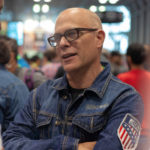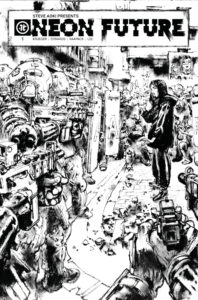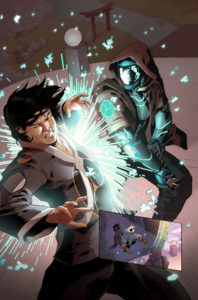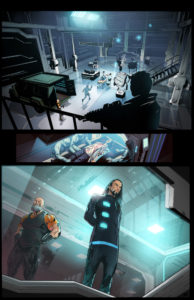I would like to preface the interview by saying that Neon Future writing team Jim Krueger and Tom Bilyeu were initially to be interviewed together. Though there is some commonality between the questions asked, I feel it is better that both creators had an opportunity to discuss their experience and opinions on the project individually. Jim’s writing experience is extensive, including an Eisner Award winning collaboration with Alex Ross on Absolute Justice, and the voice he brings to Neon Future is unique.
ComicAttack: With books like Justice, Earth X and so many others in your catalog, you bring a substantial talent and breadth of experience to the Neon Future project. How did you get involved with Impact Theory and the Neon Future project in particular?
Jim Krueger: Well, initially, it was me just meeting Tom (Bilyeu). We had coffee one day and then he said – well he introduced himself as a giant comic fan – and he said, “Do you ever consult on comics?” He was thinking of putting something together and I had no idea that he has already had this project with Steve Aoki in the works. I had no idea how great the artists [were] that we were going to get, and all that sort of thing.
CA: The art is absolutely stellar. Is this a limited series or is the intention for it to be ongoing?
JK: Well we’re writing it in arcs. We’re treating it like the first 6 issues will be the first major arc. We’ll do collections every 3 issues or so. Each issue is 28-30 pages, something like that.
CA: What influences, fiction or non-fiction, did you draw on in crafting the narrative?
JK: Well, some of it was just sitting down with Steve and talking to him about what’s important to him and how he feels and what kind of character he would like to be in the story. But then, there’s a lot of science fiction, there’s a lot of…it’s probably mainly science fiction. But what’s amazing about this book that I’ve never gotten to do in a book before is – as far as our guy, who’s our hero of the story – we’re taking our time getting it there. Like usually, there [for instance] Peter Parker’s bit, and then 10 pages later he’s already Spider-Man. This is not that. We’re telling the long story here.
CA: I absolutely appreciate the pacing. I appreciate when creators really give the characters time to breathe.
JK: Yeah, you know, that was goal of Tom’s from the beginning and when I came on board I thought, “Okay, let’s really focus on clarity. Let’s make sure that anyone – whether they’ve read a comic before or not, they can understand it.” And as we were talking to the artists, we thought, “Even they need to be able to understand this.”
CA: The technology on display is astounding but not necessarily relegated to the realm of science fiction. With the existence of movements like transhumanist-focused Humanity+ and advancements like Elon Musk’s Neuralink on the horizon, what real-world developments do you feel are way closer to realization than the average person is aware of?
JK: Oh, well, you know, what’s so interesting with this book is we’ve really tried to do technology that’s maybe only one step away from what we’ve been doing and what’s happening right now. In so many ways, we’re grabbing onto things that we’re seeing, beginning to be developed right now. Because a lot of times, a lot of times you could say, “I’m going to do a future book,” and people make up crazy things…
CA: That aren’t even remotely close to the realm of scientific fact, stuff that CAN exist.
JK: Right, right. And it’s been like a discipline with the creative team and the writers to all work together and have it all be technology that based on something that already exists.
CA: Do you feel that we as a society are ready for the things that are just around the bend, technology-wise?
JK: I don’t know if we’re ever ready for anything. You know, people have babies, and there’s no way they’re ready for that. People get married, and there’s no way they’re ready for that. Life just brings changes all the time and what’s interesting is that with more technology that’s coming, we begin to deal with the ramifications of that in the series itself.
CA: Going back into the research, in delving into the potential technological and sociological impact of this kind of dystopian iteration of America, what have you learned about our institutions and social mores that really has to change to keep pace with advancement?
JK: Social mores. Well, you know, I mean, one of the big things we deal with in the series is fear. That’s a giant one. And we live in a country right now where there’s a lot of fear, you don’t know what’s going to happen. And there are different ways to deal with that. And so, if there’s a message involved, it’s hope. It’s developing hope, creating hope.
CA: Now, dealing a little bit more specifically, but hopefully not going into stuff you can’t talk about, there seems to be a not so subtle schism in the augmented group between Mars and the leader. Is that something that is going to stay at the forefront, or is it going to get a little more subtle, a little more Machiavellian in the execution?
JK: Well, Mars is a great character and he’s not just a character who’s going to be in the background. He plays a big part in the ongoing arc. And that schism that you talk about, even then, it’s a story of you don’t always have one leader of a rebellion and the leaders don’t always get along and his schism with the Kita character is going to play itself out in some terrible ways, sometimes. I mean terrible like tragic.
CA: Oh, I’m absolutely certain. Just one more for you. Without giving away too much, was it important for you to balance the more cerebral exploration with the very visceral action that we see in the first issue? Personally, I feel, again, that the pacing was really spot-on, but I imagine that the sweet spot is something that can be difficult to maintain as the narrative becomes more layered. So what was the intention around action vs. introspection and exposition?
JK: Part of the choice to have it be the main hero remembering back and telling the story was to give us a sense of his emotions and to introduce us to a new world and what it’s like to be a human being in a new world, whether that’s someone who is augmented or not. And so our whole goal, always, was to make sure that while we’re dealing with advancements in technology that ultimately this is the most human, relatable story imaginable.
I would really like to thank Jim Krueger and the team at Impact Theory Comics for this opportunity to discuss their inaugural IP. Check out my thoughts on Neon Future in our coming review.
Neon Future is available now @ https://comics.impacttheory.com/
Christian Davenport
cable201@comicattack.net
Images by Eric Snell and Impact Theory Comics
esnell@comicattack.net







Pingback: Impact Theory Comics Review: Neon Future Graphic Novel – ComicAttack.net